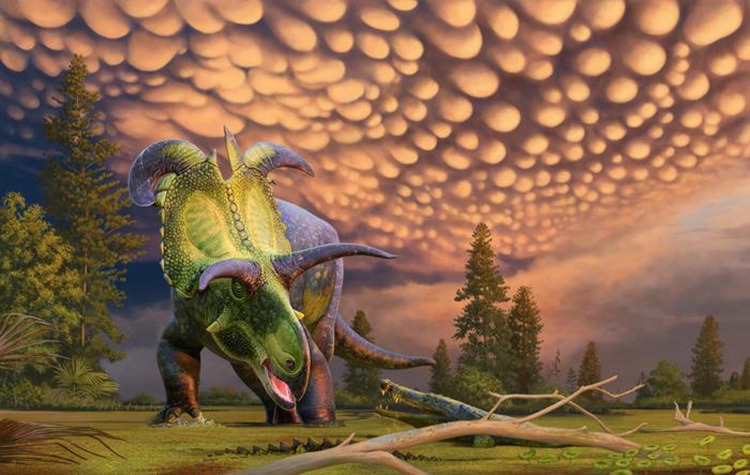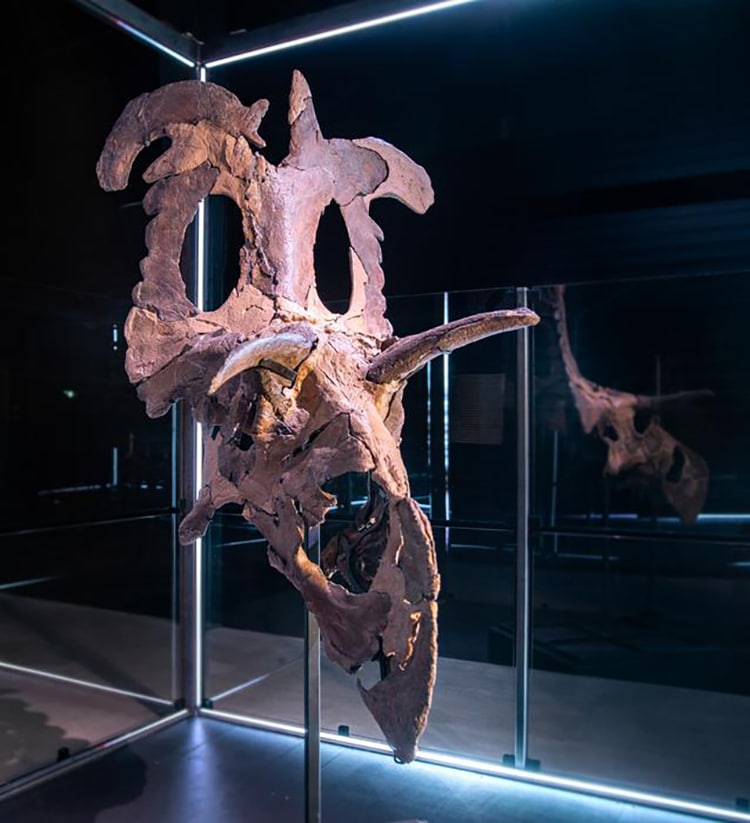
An artist depicting Lokiceratops as it may have appeared 78 million years ago in what is now Montana. (Photo: ©Andrey Atuchin for the Museum of Evolution in Maribo, Denmark, CC BY-NC-ND)
Dinosaurs range from the tallest (sauroposeidon) to the smallest (alvarezsaur). New species are continually being discovered, and yet another unique species has resurfaced from ancient rock. This fancy four-legged beast discovered in Montana has ornate horns, inspiring its new scientific name Lokiceratops rangiformis. The discovery was announced in PeerJ.
Lokiceratops rangiformis was a massive beast that roamed Earth about 78 million years ago. Stretching 22 feet long and weighing 11,000 pounds, the dinosaur walked on four legs. It had a plant-based diet. As a ceratopsid, a type of horned dinosaur, its skull evidences its unique cranial structure. It boasts two “regular” horns on its forehead. Above that is a large bone frill that fans out behind the head. Atop this frill are two unique curling horns with tiny adjoining points, one smaller than the other. Hence the name given the new species, which honors the Norse god’s horned helmet and the uneven nature of caribou antlers.
Lokiceratops also indicates that dinosaurs in the Montana and Alberta regions were more diverse and swiftly evolving than previously thought. “In addition to being one of the largest and most ornately decorated horned dinosaurs ever discovered, Lokiceratops also reveals an unexpectedly high level of richness in a Laramidia ecosystem,” Dr. Joseph Sertich tells IFL Science. Dr. Sertich is a paleontologist from the Smithsonian Tropical Research Institute and the Colorado State University and was the study’s lead author. “Even more surprising, three of the five horned dinosaurs that lived in this ecosystem are close relatives, revealing a surprising pattern of rapid, regionally restricted evolution in the centrosaurine group of horned dinosaurs, a pattern similar to birds and other animals that use display features.”
“Having a giant head like Lokiceratops required massive neck muscles to balance it on the body and lots of calories to grow as the animal matured,” shares co-author Dr. Mark Loewen, associate professor and vertebrate paleontologist at the University of Utah. “At the same time, it must have been so impressive to potential mates that it really was worth having such a huge head!”
This fancy dinosaur surely would have been impressive roaming its habitat millions of years ago, and its fossil remains impressive today.
Meet the Lokiceratops rangiformis, a massive four-legged dinosaur that roamed what is today Montana 78 million years ago.

Renditions of four centrosaurine dinosaurs who roamed together. (Photo: Fabrizio Lavezzi © Evolutionsmuseet, Knuthenborg, CC BY-NC-ND)

A Lokiceratops skull at the Museum of Evolution. (Photo: Museum of Evolution, CC BY-NC-ND)
h/t: [IFL Science, Gizmodo]
Related Articles:
What Researchers Long Thought Was Just an Agate Crystal Is Actually a Dinosaur Egg Fossil
66-Million-Year-Old Fully Articulated Dinosaur Embryo is Discovered Inside of a Fossilized Egg
Chicago’s Field Museum Exhibits Rare Skeleton of Bird-Like Dinosaur Archaeopteryx
99-Million-Year-Old Baby Bird Feathers Study Sheds Light on Dinosaur Extinction
